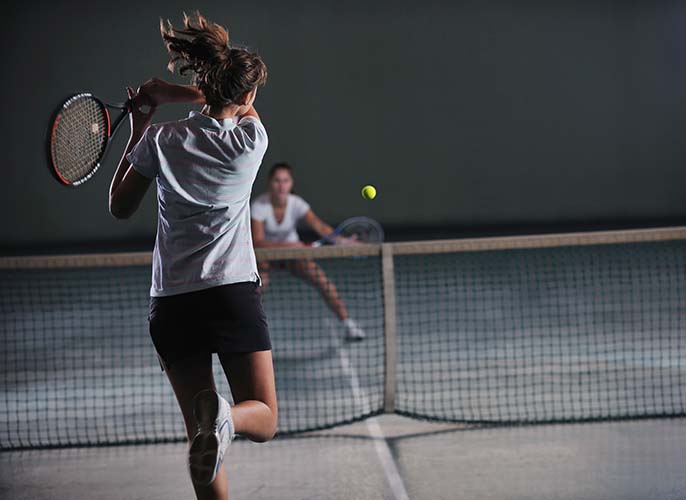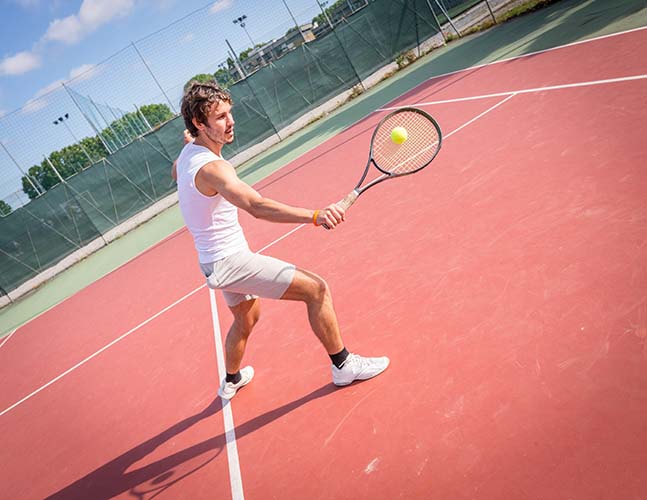Volley with a purpose
The volley makes the difference between your average weekend warrior baseline grinder and a tournament champion. A proper volley forces your opponent to make a decision with the ball quickly and limit their options. They will be forced to stay at the baseline and play their shot around you or lob a shot over the top. Many top players will only play from the baseline and beat most of the competition with consistency. Charging the net and forcing them to pass alters the game completely.
When to Volley

Understanding when to volley is more important than the mechanics of the swing itself. Most of the time, the decision to come to the net and volley should be made when the player is on offense. If you are making an effort to volley from a defensive position, any seasoned player will pick you apart. The best time to come to the net and put away your opponent with a volley will be when they're either on the run or well behind the baseline. This will allow you to either make an angled volley well away from your competitor or force a short drop that cannot be reached before the 2nd bounce.
The Dead Zone

Once you have committed to attacking the net, avoid the dead zone at all cost. The dead zone is an area located about 3 feet back from the service line all the way up to the service line itself. This area makes for exceptionally challenging shot placement. If you find yourself in this area, seasoned players can place balls at your feet; forcing you to volley from a low stance, setting you up for a kill shot. It's called the dead zone for a reason. To avoid it, place yourself about 2 feet inside the service line and anticipate the coming shot while poised on the tips of your toes with your racquet at head height.
Note : Footwork is essential in volleying. Do not be caught on the heels of your feet. Remaining on the tips of your toes will allow you to make quicker plays on the ball.
Anticipate
The name of the game at the net is to end the point as quickly as possible. Every shot your opponent has against you is a chance to either pass you or force an error. When you are in the proper position in front of the service line, your goal should be to anticipate your opponent's shot and make contact with the ball as close to the net as possible. This may mean taking a few steps forward from your current position to make contact.
As a best practice, before you strike any ball from the volley position, take your tennis racquet back as early as possible. An early backswing will prevent you from getting handcuffed. Many times it will be appropriate to hold your racquet back in a paused position at shoulder height. The closer to the net you strike the ball, the more angles you open. You'll find yourself winning more points more quickly.
Keys To The Proper Volley

- Keep Your Body Closed - A major key to the volley is making sure that you are executing it from closed body position. Any early release of your body (read: your chest showing to your opponent) causes the accuracy of your shot to deteriorate.
- Pick Your Spot - Select a point in the court away from your opponent where you wish to place the ball. Aim your lead shoulder towards that point.
- Bend Your Knees - Before the ball crosses the net, make sure both of your knees are bent and that you are always moving forward. Moving backwards in any volley reduces the velocity of the ball and can cause you to pop the ball up or lead to you sailing the ball out of play.
- Make Contact at Sternum Height - As you make contact with the ball, make sure you are connecting around the sternum of your chest and moving the racquet along a slightly downward direction. Be careful not to cut the volley shot or chop at the ball. But do make sure you are directing the shot in a downward motion.
- Finish In Front - Upon making contact with the ball and drawing the ball down towards the court, finish your swing in front of your body without releasing your chest to your opponent. This follow through is very different from the high finish over the left shoulder we would see for a forehand.
- Get Back in Position - After the ball is over the net, return to the ready position on the tips of your toes with your racquet held in both hands anticipating your next shot. Too many times players feel they have won the point before it's over and give up too early. Unless the ball has bounced twice, do not assume anything and position yourself for the next shot and play the point out in its entirety.
